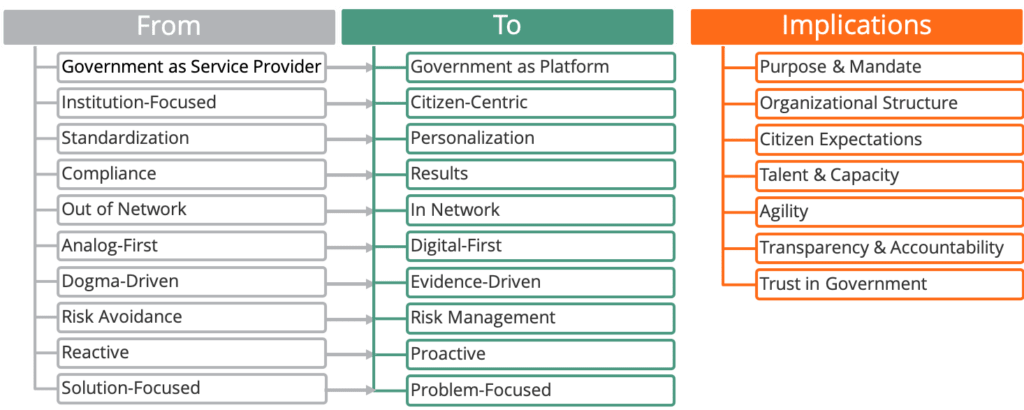The operative word in “digital transformation” is transformation. The application of digital technology does not a transformation make. That’s why much of the hype about digital transformation is underwhelming. Brian Solis defines it as “the realignment of, or new investment in, technology, business models, and processes to drive new value for customers and employees and more effectively compete in an ever-changing digital economy.”
Does this notion of business model changes using technology apply to government? Yes, according to William Eggers of the Deloitte Center for Government Insight, in his book Delivering on Digital: “much of what government does is information-based — and therefore inherently digital and convertible to bits and bytes.”
The Government’s Digital Mindset
Government digital transformation is about technology investment changes. It is about driving new value for citizens. And, it’s about “business model” changes. It’s about change. Most importantly, a digital mindset is needed.
Efficiency improvement through digital technology does not transform the value received by citizens. Incrementalism is the enemy of transformation and value.
What is Government Digital Transformation?

What is a Digital Mindset for Government?
- From Government as Service Provider to Government as a Platform
- A transition from governments providing sets of mandated services to providing these services and digitally enabling innovation through open data in what Tim O’Reilly of O’Reilly Media calls Government as a Platform
- A transition from thinking about revenue collected by selling government data to appreciating the Economic Value Add (EVA) of open government data – currently estimated as an additional 0.5% of GDP per year.
- From Institution-Centric to citizen-centric
- A transition from governments as sets of Ministries, Departments, and Agencies (MDAs) with overlapping mandates to a single view of government services seamlessly coordinated across MDAs, as described by the McKinsey Center for Government, leveraging customer experience (CX) techniques, to improve citizen wellbeing
- A view to “hacking bureaucracy” as described in Delivering on Digital, including hacking delivery and silos to create “horizontal government”
- From Compliance to Results
- A transition from a focus on rules compliance and compliance audits to outcomes and performance audits, that the United States Government Accountability Office (GAO) concludes “has a vital role in providing decision-makers and citizens with the information, analysis, and recommendations they need to respond to this increasingly complex and interconnected environment”
- A switch from traditional incremental budgets to using results-based or performance budgeting techniques, described by UNESCO as a “participatory and team-based approach to management designed to improve programme delivery and management effectiveness, efficiency and accountability that focuses on achieving defined results, and should be applied in all stages of programming”
- From Risk Avoidance to Risk Management
- A transition from avoiding perceived risks, especially around potentially breakthrough new technologies and techniques, to risk mitigation
- From Standardization to Personalization
- A transition from standardizing and homogenizing government services to providing the right service most effectively based on context
- From Out-of-Network to In-Network
- A transition from government operating as a broadcaster of information to active social networking as described in the FreeBalance and Grant Thornton Embracing Government 2.0 white paper
- From Analog-First to Digital-First
- A transition from thinking about digitizing manual processes, and thinking about government processes as manual and electronic documents to process reinvention based on digital technology
- From Dogma-Driven to Data-Driven
- A transition of policy as driven by political dogma to data-driven and evidence-based policy
- From “Tried & True” to Experimentation and Innovation
- A transition from using conservative methods of procurement with long projects, waterfall methods, and large vendors to small projects with experiments to drive government innovation through agile government procurement
- From Solution-Focused to Problem-Focused
- A transition from applying solutions that worked in the private sector or other government organizations to focusing on problems to be solved, using techniques such as Problem-Driven Iterative Adaptation (PDIA)
- From Reactive to Proactive
- A transition from reacting to social and economic changes to scenario planning and predictive analytics to prevent problems before they occur
What Are the Change Implications of Adopting a Digital Mindset in Government?
There are several change management implications to enable the government’s digital mindset:
- Mandate and Purpose
- Government institutions need to reconsider or clarify mandates away from fuzzy objectives to coalesce stakeholder support
- Outcomes, rather than inputs and outputs need to be part of government organizational mandates
- Organization
- Governments need to consider reorganization to create pockets of innovation like Centres of Excellence, and digital services groups for experimentation, and to troubleshoot technology problems, leveraging public servants on secondment and contract employees from the private sector
- Expectations
- Government leaders need to communicate that fast failures are expected in digital initiatives – that the agile concept of experimentation for learning is how public servants will be judged
- Incentives
- Public servant incentives need to reflect the switch to the digital mindset, including advancement based on digital merit
- Performance structures and performance appraisal methods need to be transformed for effective civil service management
- Talent and Capacity
- Digital talent needs nurturing, training and mentoring programs are needed to build digital capacity
- Trust
- Transformation to digital needs trust, where leadership actions are consistent with expectation and incentive changes, and leaders trust public servants to experiment
- Transparency
- Policy, program actions, and expectations need to be transparent to foster trust
- Accountability
- Accountability goes hand-in-hand with incentives and trust
- Anticipatory
- Decision-makers need to transition from focusing on reporting on the past, to finding patterns that predict the future
- Scenario planning becomes a critical skill
- Agility
- A digital mindset requires leveraging agile techniques such as lean, SCRUM, Kanban, design thinking and PDIA
- Technology
- Legacy technology is often the biggest inhibitor to holistic digital services and transformation, current investment in obsolete technologies and, what Gartner calls legacy ERP needs to be reconsidered, with the transition to cloud technologies as an enabler
